In this article:
Restless leg syndrome causes an uncomfortable feeling in the leg, most notably when sitting or lying down, leading to an overwhelming desire to move the leg. Moving the leg relieves the discomfort temporarily, but it reappears after a short time.
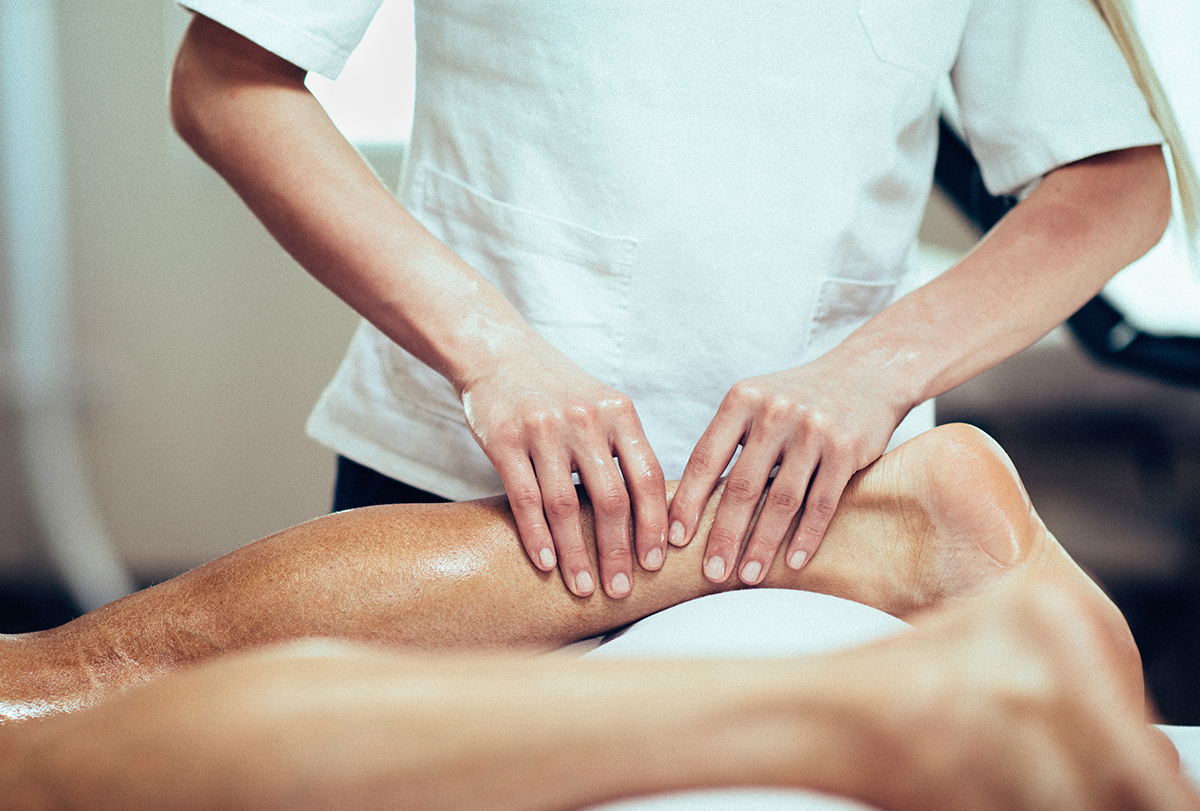
Restless legs syndrome is basically incurable but can be managed with proper prescription medications, self-care measures, and other therapies. You can also try certain natural remedies to keep symptoms at bay.
Home Remedies for Restless Legs Syndrome
Here are some home remedies that may help relieve restless legs syndrome:
1. Hot and cold foot soak
Alternating use of warm and cold soaks for your leg muscles can help reduce cramping and can ease the pain associated with restless legs syndrome. The heat stimulates blood circulation, whereas the cold helps curb inflammation. (1)
How to use:
- Fill one bucket with cold water and another with bearable hot water.
- Put your feet in the hot water for 3 minutes.
- Then, dip them in cold water for 10 to 60 seconds.
- Repeat two or three times.
- Follow this regimen twice daily for effective results.
2. Take an Epsom salt bath
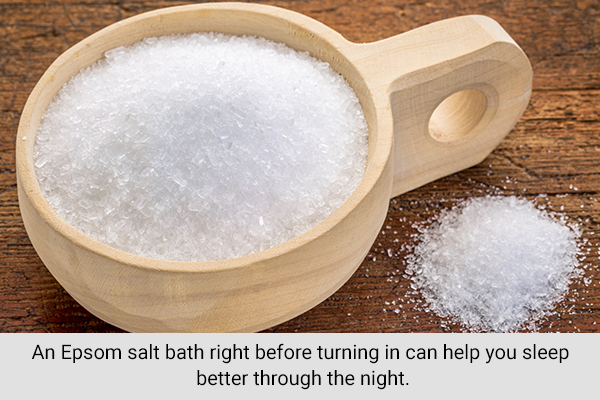
An Epsom salt bath right before turning in can help you sleep better through the night. The high amount of magnesium sulfate present in Epsom salt helps soothe sore muscles and calm the nerves. (2)
How to use:
- Pour 1 cup of Epsom salt into warm bath water. Use your hands to stir the water to help the salt dissolve better.
- Soak in the bath for at least 30 minutes.
- Do this daily.
3. Drink tonic water
Tonic water is a carbonated soft drink containing quinine, a compound that can help settle the nervous system and provide relief from various symptoms of restless legs syndrome. It acts as a muscle relaxant and improves blood flow to the muscles. (3)
How to use:
Drink ¼ cup of tonic water before going to bed each night. Sip it slowly so the body has time to absorb the quinine.
Note: Large doses of quinine have side effects, but about 20 mg of quinine per eight ounces of tonic water is safe to use.
4. Sip on a cup of chamomile tea
Chamomile is a herb that acts as a mild sedative to relax the nerves and muscles. Regular use will promote sound sleep. (4)
How to use:
- Enjoy a warm cup of chamomile tea to relieve tension and stress in the nerves and muscles. Drink this tea 1 to 2 hours before bedtime.
- Alternatively, massage your legs with chamomile oil for a few minutes before going to bed.
5. Blackstrap molasses can help
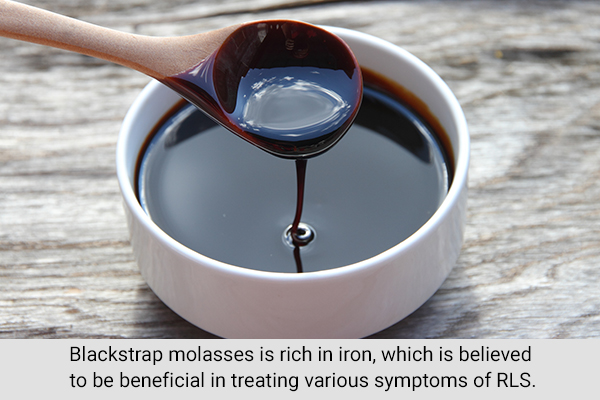
Blackstrap molasses is rich in iron, which is believed to be beneficial in treating various symptoms of restless legs syndrome. (5) An integral component of hemoglobin, iron helps transport oxygen from the lungs to different cells of the body. Iron is also indispensable for energy production and metabolism.
In addition to iron, blackstrap molasses also contains other minerals including calcium and potassium. Blackstrap molasses is available at most health or natural food stores.
How to use:
- Stir 1 tablespoon of blackstrap molasses into 1 cup of water.
- Drink this solution half an hour before retiring to bed.
- Do this daily for best results.
You can also drink a combination of 1 tablespoon each of blackstrap molasses and apple cider vinegar mixed in 1 cup of water.
6. Reap the benefits of peppermint
Peppermint has high menthol content that can help numb the restless feeling in your legs and provide pain relief to aching muscles. (6)
How to use:
- Drink a cup of peppermint tea before going to bed to relax the muscles and promote restful sleep. In fact, 3 to 4 cups of peppermint tea in a day is considered healthy.
- Alternatively, apply peppermint oil directly on the legs and then gently massage your legs for 5 to 10 minutes. This will help relieve tension.
7. Lavender oil can give you relief
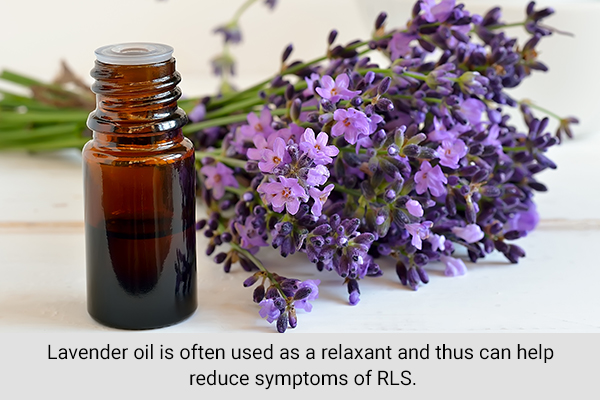
Lavender oil is often used as a relaxant and thus can help reduce symptoms of restless legs syndrome. Additionally, the aromatic scent of the oil has a calming effect that can lull you to a good night’s sleep. (7)
How to use:
- Simply rub a few drops of lavender oil on the bottom of each foot before getting into bed each night.
- Alternatively, add a few drops of lavender oil to a small tub of lukewarm water. Soak your feet in this water for 10 minutes before going to bed each night.
8. Try using camphor
Camphor has therapeutic and antispasmodic properties, which make it a go-to product for relieving inflammation and alleviating restless legs syndrome symptoms.
How to use:
- Gently rub a small amount of camphor oil on your legs before going to bed. Within minutes, the tingling sensation in your legs will go away. Do this daily.
- You can alternatively use camphor cream for the same effect.
9. Massage with coconut oil
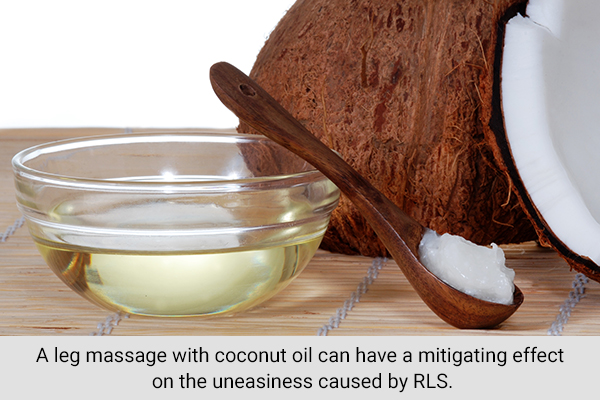
A leg massage with coconut oil can have a mitigating effect on the uneasiness caused by restless legs syndrome. It works by improving blood circulation and relaxing the nerves to help you sleep soundly at night.
How to use:
- Slightly warm some coconut oil and then massage it all over your legs.
- Rub the oil in your legs using circular motions of the hands, moving upward from the ankles.
- Do this daily to relax your muscles.
You can also use warm mustard oil as a suitable alternative.
Prevention of Restless Legs Syndrome
- Cultivate healthy sleep habits that could help make up for the loss of sleep caused by this condition and help cancel out the detrimental effects of restless legs syndrome to some degree.
- Because a deficiency of iron and other vital vitamins is often associated with restless legs syndrome, it is advisable to consult your doctor about possible inclusion of the requisite supplementation of iron or vitamin D, C, or E in your diet.
- Going by anecdotal evidence, keeping your bedding loose can help by allowing your feet to rest in a natural position.
- Sleeping with your legs in an elevated position, generally with the help of a pillow, can work to reduce the symptoms of restless legs syndrome.
- Caffeine, alcohol, and nicotine can aggravate the symptoms of restless legs syndrome and thus should be kept at a minimum if not discontinued altogether.
- Engaging in miscellaneous activities that keep your brain preoccupied helps with the anxiety that often comes as part and parcel of restless legs syndrome. Knitting, crossword puzzles and other games, reading, or just a deep meaningful heart-to-heart are just some of the ways you can keep your mind off your symptoms.
- Incorporating moderate exercise in your daily routine can help relieve restless legs syndrome symptoms and can help induce better sleep. However, it is essential that the exercise should not put undue strain on any points of pain and discomfort.
Final Word
The above-listed remedies can help calm your legs to enable you to get a good night’s sleep.
Prolonged sleep deprivation on account of restless legs syndrome can be quite damaging for your entire body and pave the way for other health issues. So, you should do everything you could to get the problem under control.
The length of time needed for these remedies to work varies depending upon the severity of your symptoms.

- Was this article helpful?
- YES, THANKS!NOT REALLY


